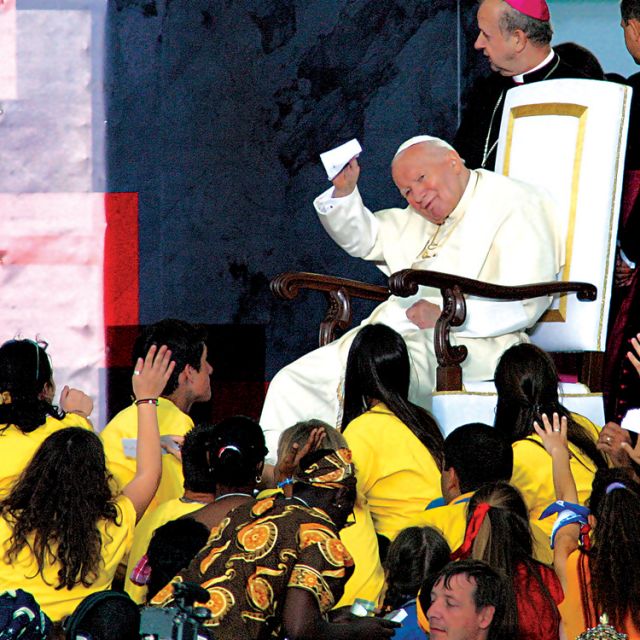Rouleau and her brigade of doctors, nurses and EMS workers were dealing with heat exhaustion, dehydration, hypothermia, heart attacks and seizures, sprained ankles, asthma attacks and more. Over six days the World Youth Day medical team treated close to 5,000 and more than half of them needed the care of a doctor.
In the middle of it all, that tiny little baby was on the edge of something terrible.
“By the time this baby came to our attention at noon, I can tell you that Dr. Laura Hans from St. Michael’s Hospital who received that baby, if it had not been for her extreme expertise in rehydrating a newborn, we could have had more difficulty,” she said.
The baby survived. In fact, nobody died during the massive week-long event that sent young people from around the world into Canadian parishes serving meals to the poor, constructing a Habitat for Humanity home, discovering themselves, their capacity for friendship and the meaning of Church.
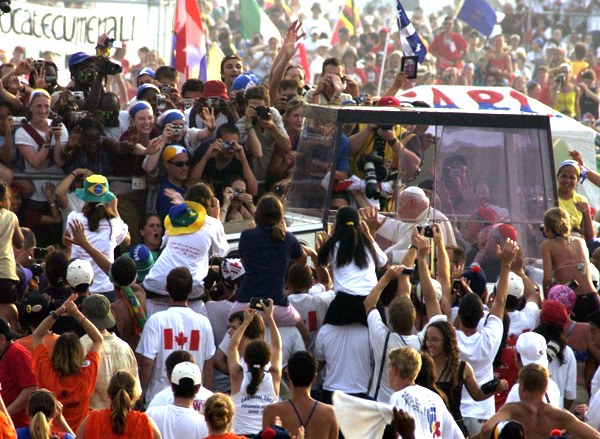
Crowds try to catch a glimpse of Pope John Paul II as he arrives at TORONTO's Downsview Park at World Youth Day 2002 (Photo by Michael Swan)
As national director of World Youth Day 2002, Fr. Tom Rosica oversaw a staff of about 300, most of them too young and inexperienced to be reasonably entrusted with the jobs they were doing. They came from 40 countries and spoke even more languages. From July 23 to 28 the team managed a core participation of 145,000 pilgrims from 70 countries. But the final Mass and stations of the cross on University Avenue drew extraordinary crowds — more than half-a-million to see the passion of Christ acted out and projected onto the office towers of a downtown boulevard and then 800,000 to see frail, elderly Pope John Paul II celebrate Mass and challenge a generation to risk everything, to go out into the deep water, for the sake of Christ.
At the 10-year mark Rosica is still repeating a message he began pitching a year before the crowds gathered.
“It’s about sowing seeds. It’s not a story of success for a rock concert, but it’s about sowing seeds,” he recently told The Catholic Register.
His favourite image for World Youth Day is of a timed release capsule.
“It’s not a panacea. It’s not a quick fix. Those who expected the churches to be full and all kinds of other things, they sort of say, ‘Well, what happened?’ ” said Rosica. “World Youth Day is supposed to stir things up and give people new lenses to look at the Church. It’s for the whole Church. It gives the Church hope.”
There’s no hope-o-meter that can tell us how much hope WYD 2002 injected into the Church. What happened during World Youth Day mostly happened to individuals and is still happening.
“My vocation, clearly, was born in World Youth Day,” said Deacon Pedro Guevara Mann, who was ordained May 26 this year.
Guevara Mann certainly didn’t know he was on that path when he signed up as artistic director of World Youth Day. Back then he was a young actor and some-time musician. Working for the Church on this massive event was a major shift from shooting TV commercials and auditioning for plays. By the time it was over, he discovered he wasn’t quite so interested in the working life of an actor.
Ten years on, Guevara Mann is still working with Rosica as a radio host and film producer at Salt+Light TV — the television, Internet and publishing entity established in the wake of WYD 2002.
What happened to Guevara Mann at World Youth Day didn’t happen all at once.
“It’s little changes that happen, that shift your idea of what it means to be a disciple, what it means to be an apostle, what it means to serve, what it means to work for the Church,” he said.
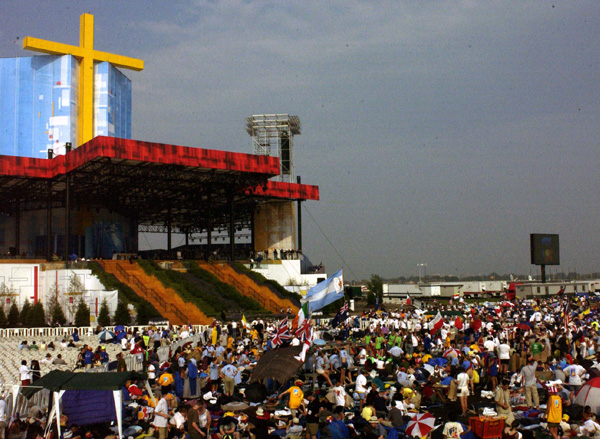
Crowds of close to 800,000 pilgrims gathered at Toronto's Downsview park (photo by Michael Swan)
Nicholas Pappalardo met Marta while working on World Youth Day. Ten years later they have two children and Pappalardo works in Ottawa in the Prime Minister’s Office. At 22 all Pappalardo had to do was persuade some 200 pastors in Toronto to get on board so he could assemble and train 1,000 volunteers who co-ordinated sleeping arrangements for the 35,000 pilgrims who were billeted in 15,000 private homes. There were also the 118,000 pilgrims to be put up in 395 area schools. He spent a year going from parish to parish to persuade each to establish a hosting committee to match families with pilgrims.
“If I had been older and more cautious I probably never would have embarked on it. We just trusted the Holy Spirit and got people excited about welcoming strangers in their homes,” he said.
After the planes slammed into World Trade Centre and the Pentagon Sept. 11, 2001, persuading people to trust complete strangers from far-off lands was not easy.
“That was a major setback. We thought there would be a lot of mistrust of foreigners coming in, even if they were young pilgrims,” said Pappalardo.
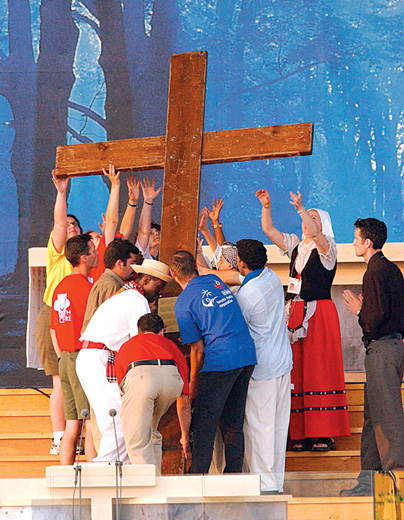
A group of international youth raises the World Youth Day cross at an evening prayer vigil in Downsview Park in Toronto during World Youth Day 2002. (CNS photo/Karen Callaway)
There was serious talk at that point of putting off World Youth Day. Add to that the drumbeat of Church-related sex abuse scandals that had people worried about sending young people into the homes of strangers.
“The odds were totally against us in setting up a home-billeting program on such a massive scale,” said Pappalardo.
Pappalardo discovered that ordinary Catholics were capable of doing something radical.
“You take this with you, this experience working with an outstanding team of people from around the world.... The friendships we forged, that experience is something that I’m proud of that will never drop off of my resume,” he said. “It’s still to this day an opportunity to evangelize and it continues to change my life.”
“We used to all joke that we all had post-traumatic stress syndrome when we finished,” said Rouleau. “But now it’s like ‘Oh, do you remember when...?’ ”
At 35, Rouleau was one of the older members of the team. But at 45 she now knows she was an innocent entrusted with a huge task.
“Knowing what I know now, I would have asked a million questions (before taking the job).”
Now she teaches University of Toronto medical students things she learned during World Youth Day about leadership, collaboration, trust.
Nobody would say WYD 2002 was just a big Mass, but then again the Eucharist is the source and summit of Christian life. Maybe it was a big Mass painted on the canvas of an entire country over six days.
WYD 2002 director of liturgy Fr. Joe de Viveiros still has his head full of extraordinary images of reconciliation he saw during World Youth Days. Some of his strongest memories are of pilgrims in Duc in Altum Park (normally Marilyn Bell Park on the shore of Lake Ontario next to the Exhibition grounds) going to Confession.
“To have all these people driving by on Lakeshore (Boulevard) seeing all the purple and all sorts of young people celebrating the sacrament of Reconciliation... Sometimes we think the sacrament of Reconciliation is on its way out. But certainly for the people who went to World Youth Day the sacrament of Reconciliation is very much alive and well,” said de Viveiros.
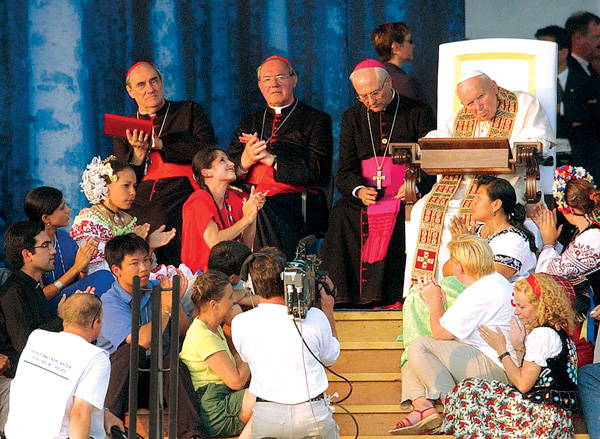
Pope John Paul II meets with World Youth Day pilgrims at Downsview Park in Toronto in July 2002. The pontiff listened as participants sang a litany of saints. (CNS photo/Karen Callaway)
From the healing of Reconciliation by Lake Ontario, World Youth Day moved to the dramatic moment of Christ’s passion re-enacted downtown. The stations of the cross on University Avenue recalled the ultimate act of reconciliation that drives Christian life.
“To bring that into the heart of Toronto and tell the world that our God incarnate shared our pain and suffering and is in solidarity with us I thought was remarkable,” said de Viveiros.
Ten years on, Rosica walks up University Avenue a couple of times a week and always recalls the images projected onto the buildings and the actors who became the Church’s central story
“That remains for me the deep legacy, the imprint of what happened with World Youth Day,” said Rosica. “It was summed up by (then Mayor) Mel Lastman who said, ‘That was the night God claimed this city for His own.’ And I really believe that.”
After pilgrims prayed the prayer of the Church, the Liturgy of the Hours, in the vigil July 27, there were thousands of young people silent as John Paul II told them:
“The question will not go away. On what foundations, on what certainties should we build our lives and the life of the community to which we belong? Dear friends, spontaneously in your hearts, in the enthusiasm of your young years, you know the answer. And you are saying it through your presence here this evening. Christ alone is the cornerstone on which it is possible solidly to build one’s existence. Only Christ.”

